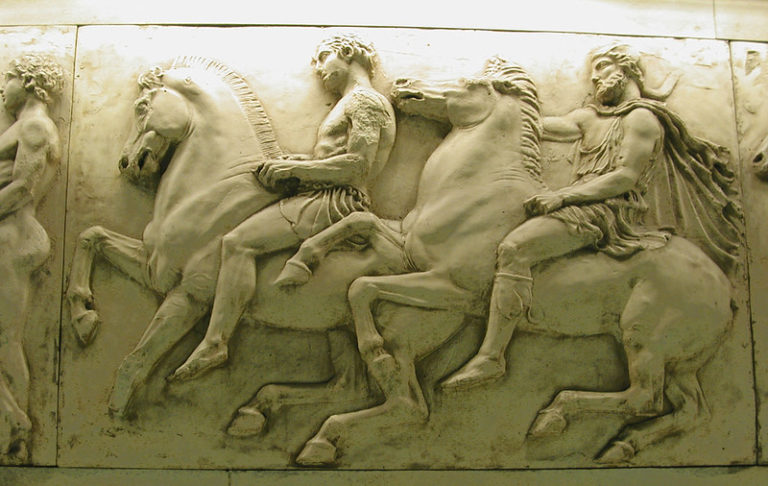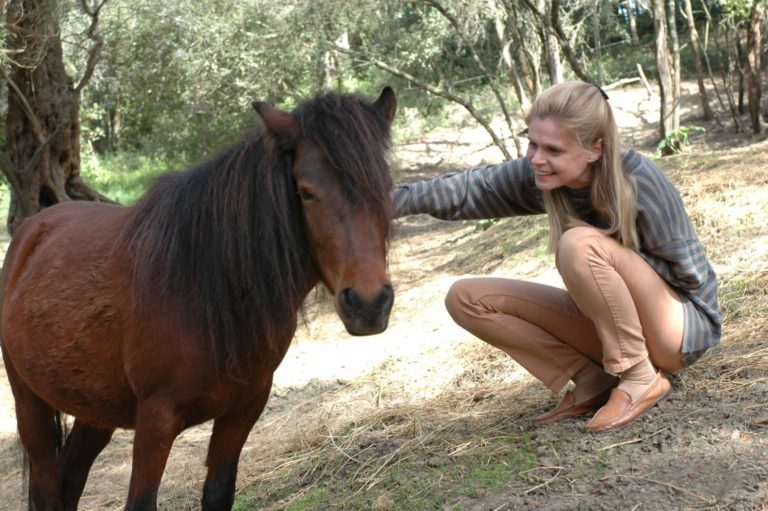Just published in Impakter Magazine, this long read for the weekend. I had a great time talking to Aliki Steen, the founder of the project to save this ancient horse from extinction! Here is the beginning:
In the past fifty years, humans have managed to destroy 60 percent of animal populations. Among them, one is of historic importance: The ancient Skyros horse, whose ancestors are said to adorn the Parthenon frieze. At the start of the 21st century, some 200 animals were reportedly left, of which only 90 could be considered genetically pure. Such a low number suggested that the horse could be facing a fatal lack in genetic variability leading to its extinction.
But the Skyros horse has found champions ready to save it. Among them, Professor Nikos Kostaras, President of AMALTHEIA, (a non-profit organization for the protection of native Greek farm animals and rare Greek livestock breeds threatened with extinction). He has worked with an American expert on horse genetics, Professor E. Gus Cothran, of the Texas A&M University’s Animal Genetics Lab, when the latter came to Greece to carry out a genetic study of the Skyros horse. Subsequently published in 2011, the study proved that the Skyros pony is “outstanding through having a distinct phenotype” and was found to be “isolated, without any relationship to any horse breed” in Greece or in the region.
I talked to Professor Kostaras about the future of this horse and this is what I learned.
Describing the Skyros horse as “one of the gems of the equine family”, he noted that it was perfectly adapted to its environment, “the result of isolation in an insular environment with poor vegetation and harsh climatic conditions.” The historical data, however, supported the idea that the Skyros horse is part of a large family of horses that lived in most Aegean islands, and for thousands of years, were “serving humans in their day to day activities.”
The problems arrived with the mechanization of agriculture that caused a steep population decline, and, he said, even extinction of some Aegean horse populations. Among the threatened species, we have the Skyros horse, the Rodos small horse (with a total population of 12 horses), and the ‘Mintili’ the small horse from the Island of Lesvos, thought to be extinct from the 1960s and rediscovered in 2017 in a feral state.
However attempts to preserve the Skyros horse were, he said, “short-sighted and had devastating effects.” In particular, there were two “major bottlenecks” resulting in the loss of precious genetic variability. The loss of genetic variability, he pointed out, is “a major threat to the survival of the breed.”
The creation of the "Skyrian Horse Society" in 2006 was a first step in the right direction. The society kept a studbook, recording all the Skyros horses that live on Skyros island, the rest of Greece and abroad, thus setting the breed standard.
He described how the Skyrian Horse Society has set out to overcome the loss of genetic variability problem, focusing its strategy on increasing the population size without risking further loss of variability. For this, he explained, all horses have been DNA tested and each horse’s inbreeding coefficient established. This enables the development of optimum out-crossing plans and thus the long-term survival of the breed.
Today the population of the breed, he reported, has increased to approximately 400, of which 160 exhibit all phenotypic characteristics of the breed. Another study is presently underway to assess the current status of the breed.
Among those leading this conservation action, he said, was and still is The Silva Project in Corfu and the Katsarelias Simpson project in Skyros.
Armed with this information and the good news that the Skyros horse population has practically doubled from where it was a couple of decades ago, I set out to interview Aliki Steen who is a founder and working on The Silva Project in Corfu and Athens, one of the two leading conservation programs mentioned by the professor.
I discovered that the SILVA breeding program started in 1996 with four horses, two stallions and two mares. The horses were originally brought to Corfu because they required living and breeding free and in a semi-wild environment which was provided at Villa Silva, an olive grove near Corfu town owned by Aliki Steen’s family.
Over time, the total number reached 45 purebred horses, although there are fewer now in Corfu because The SILVA Project “helped” other breeding centers in Greece and abroad (e.g. in Peebles, Scotland): The horses were “given away”, not sold, in order to create additional breeding centers.
From the start, the program was and is engaged in advocacy to make the public - and also potential breeders - sensitive to its cause.
The program is also engaged in equine therapy, with the special needs of about 30 children attended to every year. In relation to this, a Silvaland Riding Center has been established with both therapeutic and classical riding programs. In addition to the usual riding facilities, there is a café, and the Center organizes a variety of activities, including dog shows and horse riding competitions. It also offers an internship program and runs a 20-acre organic kiwi farm. A rare Greek breeds Educational and Environmental Park based at Silvaland is under development intended for school children and tourists.
I had a long talk with Aliki Steen who joined her family’s project from the start (1996) in parallel with her work in finance. Born in Athens, Greece, from a Greek mother and a Norwegian father, she came to Brussels in 1983 for her studies, then worked for several years in finance, her latest position being director of global internal communication for a large international banking group.
[caption id="attachment_59197" align="aligncenter" width="768"]
How are your horses today, any recently-born foal or happy event on the way?
Aliki Steen: The Skyros horses on Corfu island are living in a little earthly paradise, called Villa Silva, in Kanoni near Corfu town. Our current "working" horses, that is the small horses used for riding for children and therapeutic riding for people with special needs, are kept on other premises, near the village of Kalafationes, in the center of the island. This riding ranch is called Silvaland and it is better suited for riding during the rainy winter days or during the very hot summer period.
For the moment, we do not have any pregnant mares on the property - ideally, each mare should be pregnant only once every five years. The older Skyros horses are all in great shape and, as some of you may know, they also live much longer than other "modern" horses - 40 years or so if they get good food and appropriate veterinary care.
That is a remarkably long life span! Can you tell us how the island of Corfu was affected by the coronavirus pandemic?
A.S.: Most coronavirus cases in Greece were observed in Athens, Patras, and the Northern part of Greece. All islands, Corfu included, were preserved, mainly because the Greek government took very strict confinement measures from the very beginning. Experts say that both the stringency of those measures and the way Greeks have largely abided by them, have been key to Greece avoiding the worst ravages of the global pandemic.
As of Monday 25 May 2020, the internal borders have finally opened and it is possible to travel anywhere in Greece. As from June-July, tourists will certainly travel to the Greek islands, but everyone hopes that the relevant social-distancing measures will help contain a potential second coronavirus wave.
How did Greece manage to cope so well with the pandemic?
A.S.: The coronavirus outbreak in Greece should have been a disaster. As a popular tourist destination, Greece received 27 million visitors in 2019 alone—presenting a potentially significant risk of COVID-19 from international travelers. The country’s population is the second-oldest in the E.U. (behind only Italy), its health sector has been ravaged by austerity, and its crippled economy is still nearly 40% smaller than it was in 2008, before the last global financial crisis.
Officials said in 2019 that, after three bailouts and drastic cuts to its public healthcare system due to austerity, there were only 560 ICU beds in the entire country of 11 million - that is 5.2 beds per 100,000 people, compared to Germany’s 29.2. The conclusion is clear: Full application and respect for quarantine measures made the difference.
Let me turn now to your project, saving the Skyros horse from extinction. Can you tell us how The SILVA Project was born?
A.S.: In 1995, my Greek family and I discovered that the 'Skyros small horse', an ancient Hellenic breed, was endangered and on the verge of extinction. Since this horse doesn't live in captivity or in stables, it was imperative that a large property was found, adapted, and used for its breeding. With very little knowledge about horses in general, we started breeding in extremis the very last purebred horses that remained in Greece. This is how in 1996 The SILVA Project was born in Corfu, Greece.
What were the challenges you confronted?
Read the rest of the interview on Impakter, click here.
-----------------------------------------------------------------------------------------------------------------------
In the featured photo: Parthenon Frieze, detail. Note the size of the riders in relation to the horse - long thought that the enlargement of humans was a way to indicate their elevated status, it is now believed that this is an exact representation and that they were, in fact, riding small horses - i.e. the Skyros horse. Source: Urban Grammar


Comments